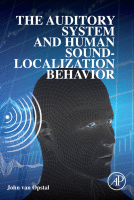Browse content
Table of contents
Actions for selected chapters
- Full text access
- Book chapterAbstract only
Chapter 1 - A Brief Introduction to the Topic
Pages 1-22 - Book chapterAbstract only
Chapter 2 - The Nature of Sound
Pages 23-50 - Book chapterAbstract only
Chapter 3 - Linear Systems
Pages 51-86 - Book chapterAbstract only
Chapter 4 - Nonlinear Systems
Pages 87-112 - Book chapterAbstract only
Chapter 5 - The Cochlea
Pages 113-146 - Book chapterAbstract only
Chapter 6 - The Auditory Nerve
Pages 147-169 - Book chapterAbstract only
Chapter 7 - Acoustic Localization Cues
Pages 171-208 - Book chapterAbstract only
Chapter 8 - Assessing Auditory Spatial Performance
Pages 209-244 - Book chapterAbstract only
Chapter 9 - The Gaze-Orienting System
Pages 245-272 - Book chapterAbstract only
Chapter 10 - The Midbrain Colliculus
Pages 273-304 - Book chapterAbstract only
Chapter 11 - Coordinate Transformations
Pages 305-332 - Book chapterAbstract only
Chapter 12 - Sound Localization Plasticity
Pages 333-360 - Book chapterAbstract only
Chapter 13 - Multisensory Integration
Pages 361-392 - Book chapterAbstract only
Chapter 14 - Impaired Hearing and Sound Localization
Pages 393-412 - Book chapterNo access
Subject Index
Pages 413-423
About the book
Description
The Auditory System and Human Sound-Localization Behavior provides a comprehensive account of the full action-perception cycle underlying spatial hearing. It highlights the interesting properties of the auditory system, such as its organization in azimuth and elevation coordinates. Readers will appreciate that sound localization is inherently a neuro-computational process (it needs to process on implicit and independent acoustic cues). The localization problem of which sound location gave rise to a particular sensory acoustic input cannot be uniquely solved, and therefore requires some clever strategies to cope with everyday situations. The reader is guided through the full interdisciplinary repertoire of the natural sciences: not only neurobiology, but also physics and mathematics, and current theories on sensorimotor integration (e.g. Bayesian approaches to deal with uncertain information) and neural encoding.
The Auditory System and Human Sound-Localization Behavior provides a comprehensive account of the full action-perception cycle underlying spatial hearing. It highlights the interesting properties of the auditory system, such as its organization in azimuth and elevation coordinates. Readers will appreciate that sound localization is inherently a neuro-computational process (it needs to process on implicit and independent acoustic cues). The localization problem of which sound location gave rise to a particular sensory acoustic input cannot be uniquely solved, and therefore requires some clever strategies to cope with everyday situations. The reader is guided through the full interdisciplinary repertoire of the natural sciences: not only neurobiology, but also physics and mathematics, and current theories on sensorimotor integration (e.g. Bayesian approaches to deal with uncertain information) and neural encoding.
Key Features
- Quantitative, model-driven approaches to the full action-perception cycle of sound-localization behavior and eye-head gaze control
- Comprehensive introduction to acoustics, systems analysis, computational models, and neurophysiology of the auditory system
- Full account of gaze-control paradigms that probe the acoustic action-perception cycle, including multisensory integration, auditory plasticity, and hearing impaired
- Quantitative, model-driven approaches to the full action-perception cycle of sound-localization behavior and eye-head gaze control
- Comprehensive introduction to acoustics, systems analysis, computational models, and neurophysiology of the auditory system
- Full account of gaze-control paradigms that probe the acoustic action-perception cycle, including multisensory integration, auditory plasticity, and hearing impaired
Details
ISBN
978-0-12-801529-2
Language
English
Published
2016
Copyright
Copyright © 2016 Elsevier Inc. All rights reserved.
Imprint
Academic Press
